If we needed a reminder of the central role which the biennial Round Ireland Yacht Race from Wicklow has grown into within Irish sailing and in the global offshore racing context during its 40 years and 20 editions, then the ramifications of its postponement from the 20th June 2020 to the 22nd August is really all that is required to signal the importance of this 704-mile challenge.
In the very complete Coronavirus COVID-19 meltdown of normal life, the numbers of sailors and others advocating such a move – or something similar - had been steadily increasing, as it became increasingly evident that the date was still available and possible, yet needed to be booked well in advance. As the time needed for the countrywide eradication of the disease is still very much an unknown - despite increasingly sophisticated analyses of its progress – the latest possible date for the race while still placing it within the summer season was the one which had to be chosen.
The sympathies of any reasonable person and all experienced sailors – particularly the large numbers who have raced in this very special event – will have been very much with Wicklow SC Commodore Kyran O’Grady and his organising team, together with their new, supportive and understanding sponsors in SSE Renewables, as they grappled with a challenging decision.
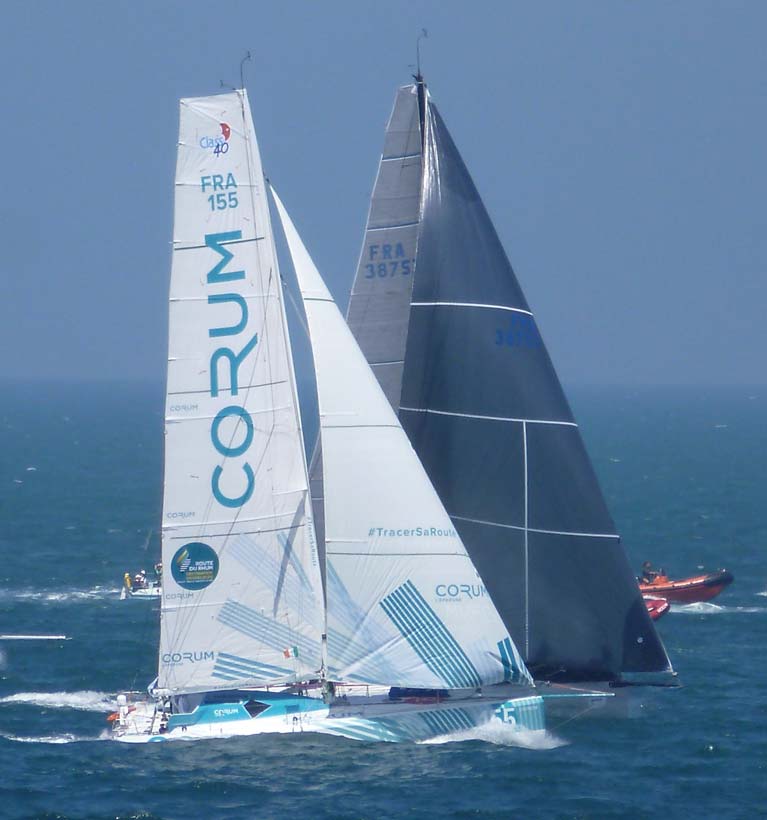 The modern Round Ireland Race has international credentials – France’s Corum and Teasing Machine battle it out at 2018’s start. Photo: W M Nixon
The modern Round Ireland Race has international credentials – France’s Corum and Teasing Machine battle it out at 2018’s start. Photo: W M Nixon
An event of this stature has a dominant position in the entire complex season-long structure of the Irish sailing programme. Thus, even when it had to be postponed by only one week to June 30th in 2018, the rest of the national cruiser-racer schedule in that period of the summer adjusted itself accordingly.
But that was a minor change by comparison with this new two months hiatus during which – if the lock-down is so successful that it can start to be significantly eased – we can expect pop-up regattas and immediate sailing events to be rapidly organised in the best flash mob-style the instant sailing becomes possible again.
In the crazy times we live in, and with everyone probably slightly off their rockers by the time we do get sailing again, it’s perfectly possible that folk will get a taste for this sort of ad hoc arrangement, and a long countdown event like the Round Ireland will seem almost quaint.
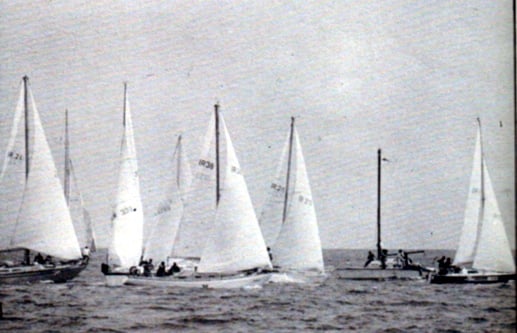 Small beginnings – the start of the first Round Ireland Race off Wicklow in 1980. The winner was Brian Coad’s Rival 34 Raasay of Melfort (centre) from Dunmore East. Photo: W M Nixon
Small beginnings – the start of the first Round Ireland Race off Wicklow in 1980. The winner was Brian Coad’s Rival 34 Raasay of Melfort (centre) from Dunmore East. Photo: W M Nixon
But by its very nature, the Round Ireland has to be a long countdown event, for it requires participating crews to have logged a certain amount of minimal experience in serious offshore competition, such that one of the strongest pressure groups in urging a specific postponement was the sailing schools, who reckoned they’d find it very difficult to fulfil their quota of qualifiers in such a truncated early season.
Yet with other potential events starting to wave flags about easily re-shaped happenings which can be put together almost overnight, serious Round Ireland owner-skippers are going to find themselves in a quandary, for although a successful offshore racing crew is not a democracy, nor is it an autocracy. Decisions are reached through a sort of osmosis.
Denis Doyle & Moonduster
In these circumstances, the best approach is to ask: “What would The Doyler have done?” Or rather, “What would The Doyler do?” For although the great Denis Doyle of Cork has been gone from among us now for 19 years - having sailed his last Fastnet Race on the Crosshaven-built Frers 51 Moonduster at the age of 81 in 2001 - his sailing inspiration and moral example is so strong that, for an entire generation of Irish offshore campaigners, it’s The Doyler who continues to be our reference point, our ever-present guide, our moral compass.
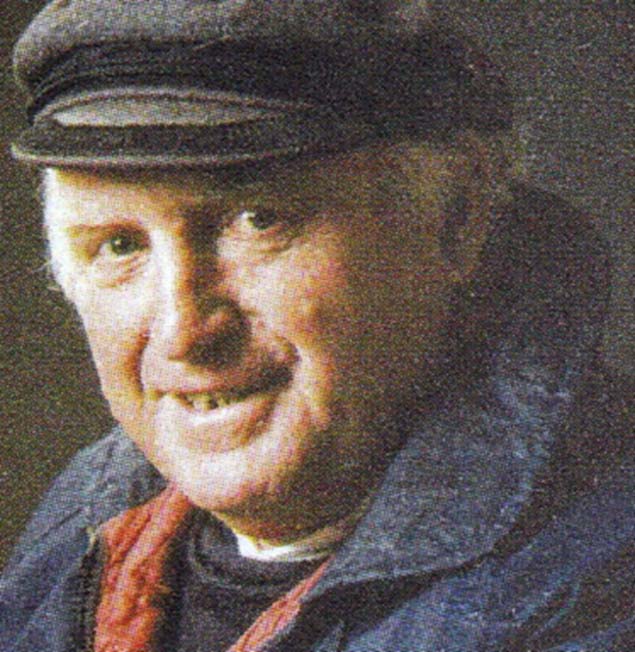 Denis Doyle – he was racing offshore for sixty years
Denis Doyle – he was racing offshore for sixty years
Yet by seeing him as such, we aren’t contravening the great Dwight D Eisenhower’s hallmark of a successful commander, which was revealed here in a fascinating piece about strategy and tactics by that renowned soldier-sailor Commandant Barry Byrne, originally of Wicklow, and no stranger to success in the Round Ireland Race himself.
The word from Commandant Byrne was that Eisenhower was totally supportive of high-level commanders and staff officers who were always planning, but didn’t have some sacred fixed Plan, other than an ultimate objective.
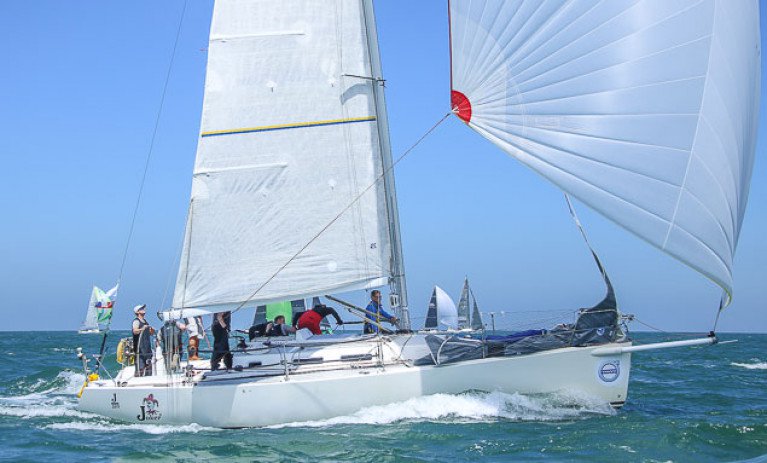 The J/109 Joker II (John Maybury, skippered by Barry Byrne) at the start of the 2018 race, in which she finished second overall. Photo: Afloat.ie/David O’Brien
The J/109 Joker II (John Maybury, skippered by Barry Byrne) at the start of the 2018 race, in which she finished second overall. Photo: Afloat.ie/David O’Brien
Thus Denis Doyle, who was racing offshore from the late 1930s until just after the turn of the century, was keen to go offshore racing, and even keener if he felt it was good for Cork, good for Ireland, and good for life generally – his ultimate objective was broad in scope.
So although the first Round Ireland Race of 1980 from Wicklow (see the first set of sailing instructions here) was seen by many in the Irish sailing community as a rather cheeky shot in the dark from a small club, Denis Doyle in Cork saw that it was good, and with his new Moonduster built in 1981, he arrived into Wicklow with this marvellous boat for the next race in 1982, and his commitment to the Round Ireland Races thereafter was complete, contributing enormously to its long-standing success.
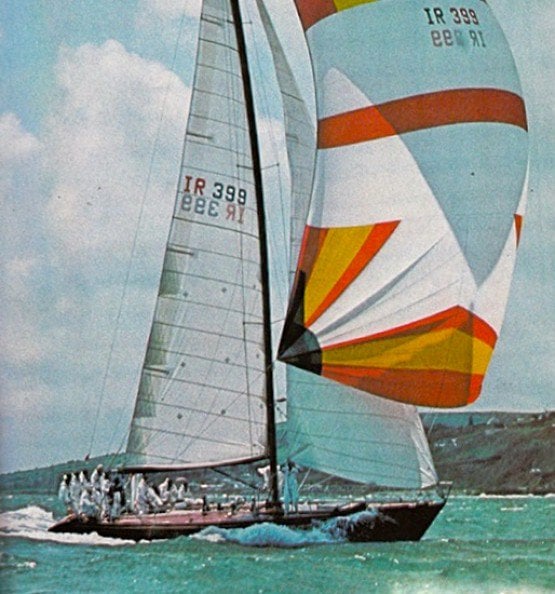 “This marvellous boat” – the new Crosshaven-built Frers 51 Moonduster in 1981. Photo: W M Nixon
“This marvellous boat” – the new Crosshaven-built Frers 51 Moonduster in 1981. Photo: W M Nixon
Now admittedly all the Round Ireland Races in which he competed – winning two of them and establishing course records in both 1982 and 1984 – were placed firmly in the final week of June, which thus left the later part of the season clear for other events for Moonduster, events which could be very distant.
For instance, one year he and three others including his ever-supportive wife Mary set out to sail Moonduster post-haste to Sardinia in order to race in the Sardinia Cup. And as well, the elegant varnished sloop was no stranger to the regattas in Galicia in northwest Spain, so much so that when I first ambled into the Monte Real Yacht Club in Bayona after an unusually agreeable Biscay crossing back in 1995, it was to note with interest that the newly-installed board listing Honorary Members was so new it had just two names on it – Denis Doyle and some guy called Juan Carlos.
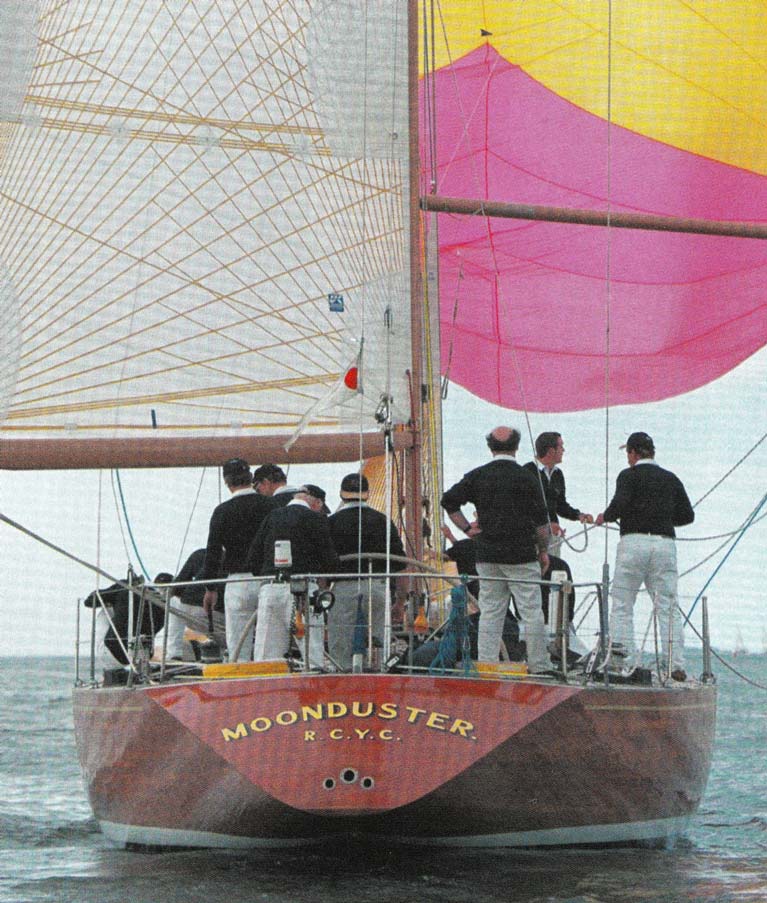 Throughout his 20 years with the Frers-designed Moonduster, Denis Doyle kept her topsides varnished. This is how she looked in 1995, at the start of the Dun Laoghaire-Dingle Race. Photo: David O’Brien/Afloat.ie
Throughout his 20 years with the Frers-designed Moonduster, Denis Doyle kept her topsides varnished. This is how she looked in 1995, at the start of the Dun Laoghaire-Dingle Race. Photo: David O’Brien/Afloat.ie
So his reach in sailing was truly pan-European, yet once he’d given his commitment to some event and its locality, his commitment was maintained through thick and thin, a commitment which remained through major changes when those changes were caused by circumstances beyond the control of the event organisers. So although the Round Ireland Race is now going to be two months late, I think we know what The Doyler would do.
For sure, the nights will be significantly longer and the weather of late August can be verging into the Autumnal. But those longer nights don’t seem quite so brutal as some of the short nights of June, for the sea has become significantly warmer and if the weather is benign, there’s a velvet quality to those longer nights which can make them a pleasantly memorable experience.
But either way – good weather or mixed – we can be sure that if Denis Doyle were still around, any ideas he might have had about other sailing plans for late August would have been scrapped in the exceptional circumstances caused by the COVID-19 outbreak, and first priority would be given to the original commitment of being on the starting line for the Round Ireland Race, even if Force Majeure has caused it to be held two months late.
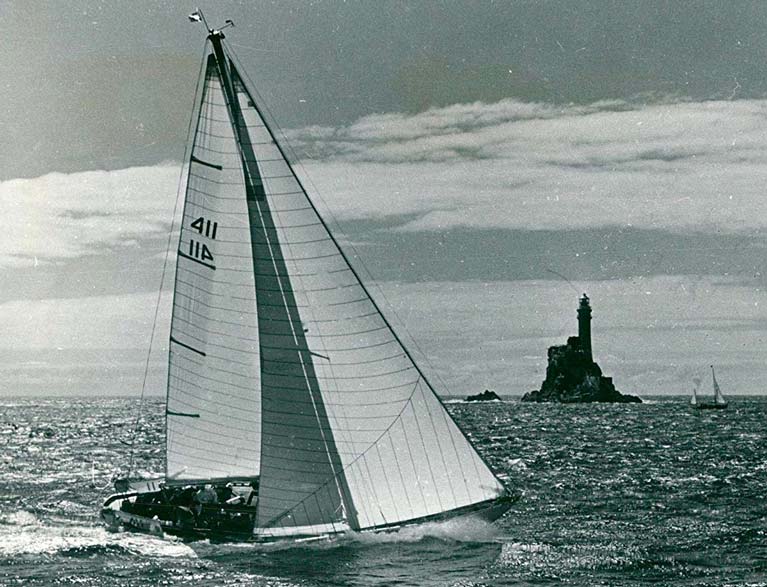 The original “white Moonduster”, a 47ft Robert Clark design built in Crosshaven in 1965, making to windward towards the Rock in the Fastnet Race of 1969
The original “white Moonduster”, a 47ft Robert Clark design built in Crosshaven in 1965, making to windward towards the Rock in the Fastnet Race of 1969
He would be there because it’s the right thing to do. This attitude was clearly revealed back in 1972, when Denis Doyle was a flag officer both of the Royal Cork YC and the Royal Ocean Racing Club, and still racing the handsome Robert Clark-designed Crosshaven-built 47ft white Moonduster of 1965 vintage. The core event of the season was one with which he was particularly involved, an RORC Cowes to Cork Race after Cowes Week, something which promised great sport for a large entry.
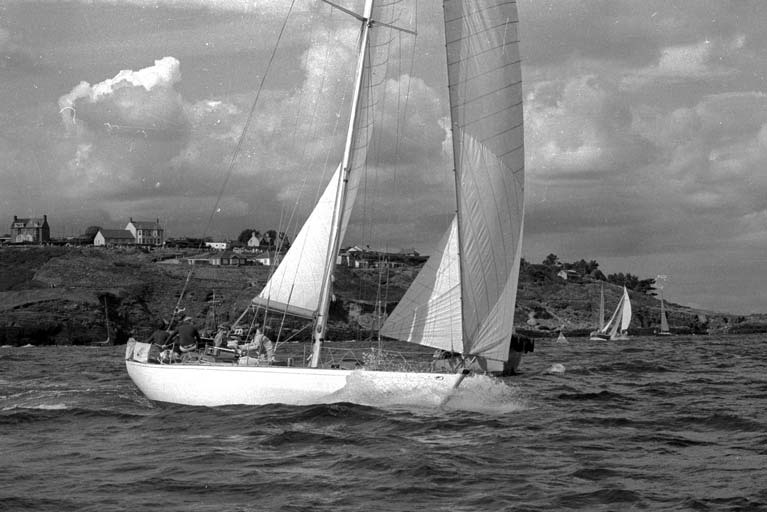 The original Moonduster manoeuvring before the start of the 1970 RORC Cork-Brest Race, after the RORC fleet had raced Cowes-Cork as part of the Royal Cork YC Quarter Millennial celebrations. Photo: W M Nixon
The original Moonduster manoeuvring before the start of the 1970 RORC Cork-Brest Race, after the RORC fleet had raced Cowes-Cork as part of the Royal Cork YC Quarter Millennial celebrations. Photo: W M Nixon
But as 1972 progressed, the Troubles in Northern Ireland deepened rapidly with much bloodshed, and the top management in the RORC became jittery about their fleet racing to “war-torn Ireland”. Denis assured them that nowhere was further and safer from the northern troubles than the race’s destination at the Royal Cork YC in Crosshaven, but he was over-ruled, and the decision was made to race instead from Cowes to Santander in Spain.
Denis took this rebuff in his usual calm way, and entered Moonduster for the 1972 RORC Cowes-Santander Race. As was her wont, Mary Doyle went out to Spain to be ready to welcome her husband and his crew at the finish. And as Moonduster glided up the river, there indeed was Mary, coolly stylish as ever, elegantly waiting beside the smoking ruins of the Real Club Maritimo de Santander. It had been blown up by Basque Separatists the night before.

































































